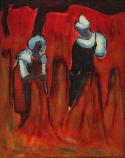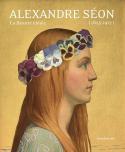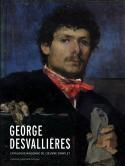Art Of The Day Weekly
#423 - from 24 March 2016 to 30 March 2016
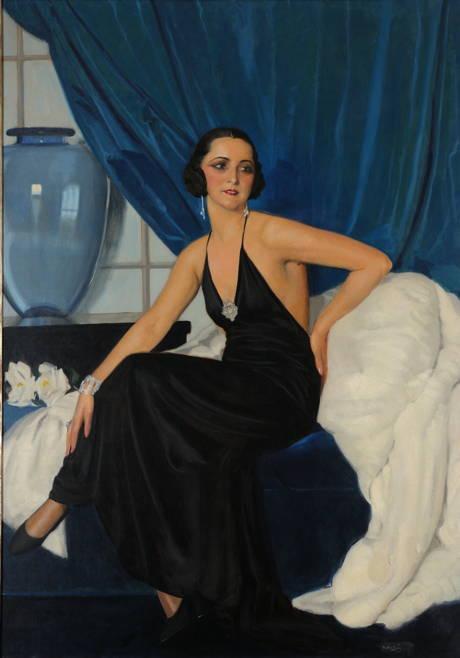
Braïtou-Sala, Portrait of Elena Olmazu, 1931. Tempera on canvas, 162x114 cm. Private Collection. Photo Alain Leprince.
IN THE AIR
Braïtou-Sala, the tragedy of a portrait painter
His itinerary is worthy of a fairy tale. He came from a modest Jewish family in La Goulette in Tunis. His father had a small grocery shop. Biographers still argue as to the exact date of his arrival in Paris, between 1901, 1909 and 1911. Albert Braïtou-Sala (1885-1972) become in the 1920s one of the greater mundane painters of Paris jet set. Without pretending to be a psychologist, he immortalised the high society of his time in their most beautiful attire. We have for example aviation hero Paul-Louis Weiller with his sublime Greek wife, Aliki Diplarakos, the first Hellenistic woman to be crowned miss Europe. There is Elena Olmazu, the brilliant sports woman and business woman from Bucarest, with her head-spining cleavage. Then there is singer Marthe Chenal, as well as the proud British baron William Garthwaite… Just like Tamara de Lempicka, Braïtou-Sala perfectly symbolises the Art déco aesthetics and it cosmopolitan swirl. She became an icon, he has been completely forgotten. Just like a large part of his family was erased from the face of the Earth, all of them exterminated in the concentration camps. He rubbed elbows with some of those who contributed to the destruction and made among others a portrait of Pétain in 1927. In decors that are dark green, bluish grey and prune color, the musée de la Piscine has carried out a true project of memory by showing this period that was so light, bubbly and carefree. For some it was simply the antichamber of Hell.
• Braïtou-Sala, l’élégance d’un monde en péril at La Piscine, from 19 March to 5 June 2016.
EXHIBITIONS
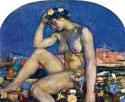
George Desvallières, Greece (Childe Harold), 1910. Oil on canvas, 143 x 158 cm. Private Collection. Photo © Suzanne Nagy. George Desvallières © Adagp, Paris 2016/droits réservés
Desvallières, the call of faith
PARIS – How can we explain this lack of interest? While thenames of some of his contemporaries, such as Jacques-Emile Blanche and Etienne Dinet, be it Ranson and Anquetin, are still known by art lovers, that of George Desvallières (1861-1950) has almost fallen into oblivion. The artist lived a long life and had quite a few trophies. He was one of the organizers of the Salon d’automne that would recognize the Fauvist painters in 1905. He is the author of large mythological compositions, of antique nudes in agressive colors. He described the life in the popular districts of Paris or London. He is also the author of large paintings for aristocratic palaces, churches and memorials such as the ossuary of Douaumont. He was a man of many facets indeed. The Petit Palais presetns him with some 90 works that span all of his career. His loss of popularity is no doubt due to his pictural Christianity close to that of Rouault and Maurice Denis: during the second half of his career he only painted religious scenes, centered on our Lord's Passion and the life of the Virgin.
• George Desvallières, la peinture corps et âme at the Petit Palais, from 15 March to 17 July 2016.

Albert Marquet, View of Le Havre Harbour (Le Quai de Notre Dame), ca. 1911, oil on canvas, 65 x 81 cm © Fondation Collection E.G. Bührle, Zurich.
Marquet, a taste for ports
PARIS – He was a friend of Matisse's, and they shared the same master, Gustave Moreau, and friendships such as that of Manguin and Camoin. But while Albert Marquet (1875-1947), took part in the Fauvist revolution in 1905, his carrer was much more discreet, as he preferred long and repetitive work on a few of his favourite motifs: the Seine, seashores and above all ports and their atmosphere. From slumbering Naples to industrial Rotterdam, all the way to Algiers, the sanctuary of the free fleet during World War II, he made a personal catalogue for himself that resembles that of Signac. The retrospective also shows other aspects of his production, including studies of characters, nudes and the more seducing sketches which made Matisse nickname him "the French Hokusai".
• Albert Marquet, peintre du temps suspendu at the musée d’Art moderne de la Ville de Paris, from 25 March to 21 August 2016.
AND IN ITALY...
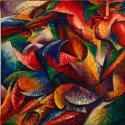
Umberto Boccioni, Dynamism of a Human Body, 1913, oil on canvas, 100 x 100 cm. Museo del Novecento, Milan.
Boccioni, 100 years
MILANO – His career was cut short by the war, as was the case of Franz Marc or Henri Gaudier-Brzeska. He suffered a stupid death, after falling from a horse, in Verona, as he was serving in the cyclists service. Nevertheless, in 34 years (1882-1916), Umberto Boccioni had time enough to leave his mark on the history of the XXth century, when he was one of the founders of the Futurist movement. The wealthy collections from Milano, in particular the 60 drawings of Castello Sforzesco, which are the guiding thread, are brought together for the first time. But the major world institutions, from the Getty to the museum of Osaka, from the foundation Barilla to the museum of Lugano, contributed to this ambitious retrospective of 260 works, among them some of the masterpieces like Elasticity (1912) or Dynamism of a Human Body.
• Boccioni, genio e memoria at Palazzo Reale, from 23 March to 10 July 2016.
A scoop on Severini
PARMA – He linked his name to the Futurist movement. But he did more than that. The exhibition at the Fondation Magnani Rocca, the beautiful home on the outskirts of Parma, shows the very complex itinerary of Gino Severini (1883-1966), who shifted from Cubist experiences to artists' books, from large mural decorations to Neo-Pointillism. Twenty five works recently allocated or rediscovered make up one of th estrong aspects of the exhibition. From 19 March to 3 July.
Macchiaioli, an ode to stains
ROME – Their name is derived from the Italian word "macchia", meaning stain. To their country they represent for the peninsula the alter egos of the Impressionists. The Chiostro del Bramante brings together 110 works by Macchiaioli, among them Fattori, Signorini and De Nittis, mentioning nine collectors of the past who defended them. From 16 March to 4 September 2016.
MUSEUMS
Pont-Aven is enlarged
PONT-AVEN – The name of this small town in Brittany is world known as an iconic site of modern painting, and in particular as a Nabi sanctuary. Yet it was necessary to wait until 1953 to see a first important exhibition dedicated to Gauguin and 1985 for the opening of a museum. It was totally thought through by the Atelier de l’Ile, and now occupies a historical location, no less that the annex to Hotel Julia, where the wealthier of the artists were lodged, as well as in an extension, which allows him to house his growing collection. Including important deposits such as those from the musée d’Orsay and from the museum of Fine Arts in Quimper. It also includes of course works by Gauguin (few of them as they are out of reach price-wise!), others by Sérusier, Maurice Denis, Emile Bernard, Vallotton. And a series of paintings by painters whose names have been erased from people's memories: Claude-Emile Schuffenecker, Henry Mosler, Anselmo Bucci, Jean Deyrolle, Maxime Maufra or Armand Seguin (1869-1903), who died too young and only left some fifteen paintings. The opening exhibition on the Rouart family is more unusual: it is at its fourt stop after Nancy, Yerres and Rueil-Malmaison.
• The museum of Pont-Aven will reopen its doors to the public on 26 March 2016.
BOOKS
Alexandre Séon, reflections of a golden age
A native son from Chazelles in the Loire region, where a street was named after him, Alexandre Séon (1855-1917) linked his name to that of Puvis de Chavannes, his unfailing supporter, and to Sâr Péladan, the moderator of the brotherhood of the Rose-Croix. A mystic and a symbolist, the forgotten Séon left some large compositions such as the one in the ceremony room at the townhall of Courbevoie, which is still visible. But this artist who always had a copy of Mona Lisa in his pocket was especially known for a series of Arcadian scenes. Nymphs picking flowers in velvet looking underwoods, ideal beauties living in settings of pink rocks and blue water, partly inspire by his vacations in the island of Bréhat. The Fée Mélusine, Orpheus, Joan of Arc, mermaids and muses accompanied through his life that was rather dark, marked by a series of failures (decorations for the townhall in Paris, illustrations of the gospel for publisher Mame) and by his bewilderment when facing men's murderous folly, which accelerated his own end, due to stomach problems in the middle of the war.
• Alexandre Séon, la beauté idéale, Silvana Editoriale, 2015, 288 p., €35.
Desvallières XXL
As the rhythm of publocations accelerates – publication and obsolescence are almost contemporary phenomenae – the catalogues raisonnés seem to remind us of the virtues of patience from another era. This publication required some twenty years of research, directed by the artist's grand-daughter. The figures are obviously very impressive: 49 pages of bibliography, 30 pages of index of the works, 2675 recent issues of which some 600 paintings, some one hundred pastels, 1600 drawings, 320 illustrations and 40 stained glass works. For each work the technique, the origin and the history of the exhibits are analyzed as much as the investigation allowed it. A long 80-year career is offerd to us in a panoramic vision, from the Prussien et le concierge, a drawing on a school notebook with lines from 1870 (the author was then 9 years old), a Notre-Dame des Neiges, an oil painting on paintd canvas from 1950, on the eve of his own death, for a small chapel at Guebwiller, in the Vosges region, very close to where his own son had died in combat during World War I.
• George Desvallières, catalogue raisonné of the complete work directed by Catherine Ambroselli de Bayser, Somogy, 2016, 3 vol., 1048 p., €380.
IN BRIEF
PARIS - The first of the five golden globes ot the Russian Orthodox church of Trinity was put into place on 19 March 2016.
PARIS - The Salon du dessin will be held from 30 March to 4 April at the Palais Brongniart.
PARIS - Drawing Now, the contemporary drawing fair, will be held from 30 March to 3 April 2016 at the Carreau du Temple.
PARIS – The multidisciplinary 100% Villette fair will be held from 22 March to 10 April 2016.
PARIS – Circulations, the festival of young European photography, will be held from 26 March to 26 June 2016 at the 104 space.
VENICE – The site of Venice was chosen the most threatened site in Europe by the association of the protection of heritage Europa Nostra. It is accompanied by seven other sites, among which the Colbert bridge in Dieppe.
ON ART-OF-THE-DAY.INFO
This week, don't miss..

MIRO. PAINTING WALLS, PAINTING WORLDS.
FRANKFURT - The Schirn Kunsthalle is dedicating a monographic exhibition to an aspect of Miró's work tahthad hardly been looked at until now. It is his clear preference for large formats and his fascination for the motif of the wall.
OPENINGS OF THE WEEK

CHUANG CHE - 50 YEARS OF ABSTRACTION
24 March 2016 - PARIS - Galerie Hervé Courtaigne
The works of a pioneer of Chinese abstract art, born in 1934

